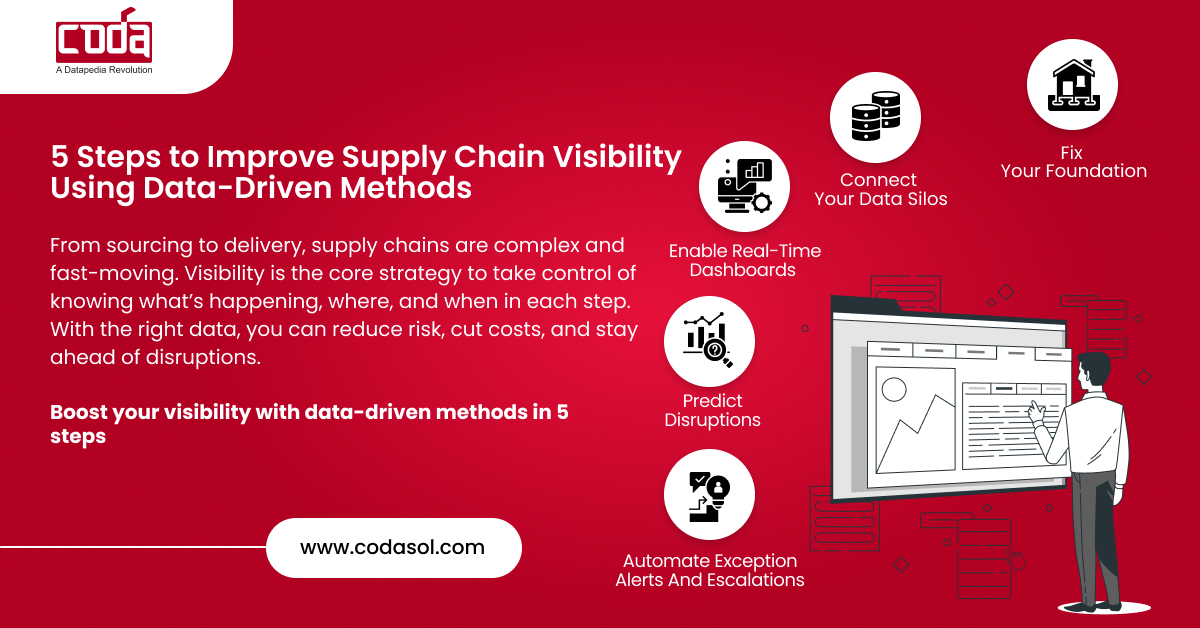Still running your supply chain on guesswork?
Shipments are late. Suppliers go silent. Dashboards claim everything’s “on time.” You don’t just have a logistics issue; you’ve got a supply chain visibility problem.
If you work in oil & gas, manufacturing, utilities, or defence, you know the cost of poor visibility isn’t just inefficiency, it’s real money lost.
Here’s how to change that.
In this post, we’ll walk through five proven, data-driven steps to help you take control of your supply chain with practical actions, not theory.
Step 1: Fix Your Foundation
Clean and Standardize Your Master Data
Why this matters
Bad data leads to bad decisions. If your material masters are full of duplicates, inconsistent naming, and outdated units, you’re making decisions with your eyes closed.
Visibility impact
- Inaccurate inventory levels
- Conflicting supplier data
- Missed reorder signals
Where to start
- Identify duplicate SKUs and materials
- Normalize units of measure across systems
- Align naming conventions between ERP platforms
- Implement a standard taxonomy such as UNSPSC
Clean master data is the foundation of supply chain visibility. Before you automate or analyze, get your data right.
Step 2: Connect Your Data Silos
Why this matters
Your procurement, warehouse, and finance teams likely operate in different systems. This disconnect leads to delays, errors, and a fragmented view of operations.
Visibility impact
- No real-time updates across departments
- Errors in procurement planning
- Siloed insights and poor decision-making
Where to start
- Map current data sources (ERP, WMS, SCM, legacy systems)
- Integrate systems through APIs or middleware
- Establish a single source of truth (ideally an MDM platform)
By connecting systems, you enable end-to-end visibility across every link in the chain.

Need help cleaning and standardizing your master data?
Step 3: Enable Real-Time Dashboards for Live Insights
Why this matters
Weekly or monthly reports can’t help you fix what’s going wrong today. Visibility must be real-time to be effective.
Visibility impact
- Delayed reaction to supply issues
- Limited accountability
- Operational inefficiencies remain hidden
Where to start
- Identify key performance indicators (KPIs) such as lead times, stock-outs, delivery performance
- Implement dashboards using tools like Power BI or Tableau
- Make dashboards mobile-friendly for on-site and remote teams
Dashboards should empower decision-makers to act, not just observe.
Step 4: Predict Disruptions Using Historical and Live Data
Why this matters
Forecasting lets you move from reactive to proactive. Data-backed predictions are your early warning system.
Visibility impact
- Spot vendor issues before they cause disruption
- Anticipate inventory shortfalls
- Reduce downtime and avoid stockouts
Where to start
- Analyze past disruptions to identify root causes
- Correlate metrics (e.g., lead times vs. vendor performance)
- Apply trend analysis or machine learning models for forecasting
The more data you feed your predictions, the fewer surprises you’ll face.
Step 5: Automate Exception Alerts and Escalations
Why this matters
When deliveries are missed or specs change, you shouldn’t find out days later. Automation ensures issues are flagged and addressed immediately.
Visibility impact
- Reduces response time to disruptions
- Improves stakeholder accountability
- Prevents costly firefighting and delays
Where to start
- Define exception thresholds (e.g., delays >2 days)
- Assign clear responsibilities for escalations
- Integrate alerts via email, SMS, or ERP messaging
Automated workflows mean fewer surprises, and faster resolutions.
Download the Supply Chain Visibility Maturity Framework & Checklist
Want to assess where your supply chain stands and what steps to take next?
Download our free PDF checklist and maturity framework.
It helps you:
- Audit your current visibility gaps
- Prioritize data and process improvements
- Align visibility goals across departments
Final Thoughts:
Visibility Isn’t a Feature. It’s a Competitive Advantage.
If you’re serious about resilience, your supply chain visibility must be:
- Real-time
- End-to-end
- Actionable
Whether you operate across India, the GCC, the Far East, or the U.S., visibility is the difference between agility and chaos.
Start with clean data. Then connect, visualize, predict, and automate.
Ready to improve your supply chain visibility?



